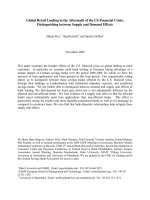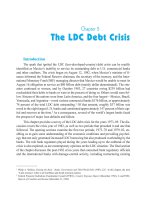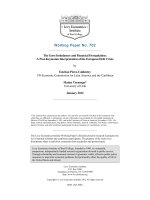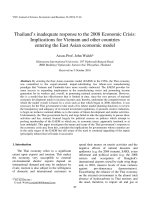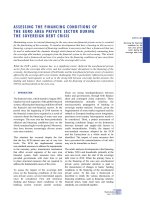Ari (ed ) the european debt crisis; causes, consequences, measures and remedies (2014)
Bạn đang xem bản rút gọn của tài liệu. Xem và tải ngay bản đầy đủ của tài liệu tại đây (5.09 MB, 292 trang )
The European Debt Crisis
The European Debt Crisis:
Causes, Consequences, Measures and Remedies
Edited by
Ali Ari
The European Debt Crisis:
Causes, Consequences, Measures and Remedies,
Edited by Ali Ari
This book first published 2014
Cambridge Scholars Publishing
12 Back Chapman Street, Newcastle upon Tyne, NE6 2XX, UK
British Library Cataloguing in Publication Data
A catalogue record for this book is available from the British Library
Copyright © 2014 by Ali Ari and contributors
All rights for this book reserved. No part of this book may be reproduced, stored in a retrieval system,
or transmitted, in any form or by any means, electronic, mechanical, photocopying, recording or
otherwise, without the prior permission of the copyright owner.
ISBN (10): 1-4438-5616-9, ISBN (13): 978-1-4438-5616-4
TABLE OF CONTENTS
List of Tables ............................................................................................. vii
List of Figures............................................................................................. ix
Introduction ................................................................................................. 1
European Debt Crisis: Causes, Consequences, Measures and Remedies
Ali Ari
Part I: Causes
Chapter One ............................................................................................... 15
Greece in the Great Depression and the European Debt Crisis:
Transmission and Process
Ayfer Gedikli and Abdullatif Ceviker
Chapter Two .............................................................................................. 59
Public Debt Crises in the Eurozone and Possible Effects on Sovereign
Credit Rankings
Ata Ozkaya
Part II: Consequences
Chapter Three .......................................................................................... 101
The Effects of the Global Crisis on Emerging Economies
Jean-Pierre Allegret
Chapter Four ............................................................................................ 127
The Transmission of Financial Crises from Advanced to Emerging
Economies: The Turkish Case
Ali Ari and Raif Cergibozan
Chapter Five ............................................................................................ 149
European Automotive Industry: Before and after the Global Financial
Crisis
Adem Baltaci and Huseyin Burgazoglu
vi
Table of Contents
Part III: Measures
Chapter Six .............................................................................................. 171
Efficiency of the FED’s Monetary Policy during the Global Financial
Crisis
Cemil Erarslan and Yuksel Bayraktar
Chapter Seven.......................................................................................... 185
A Note on the New Monetary Policy of the Central Bank of Turkey
Fatih Ozatay
Chapter Eight ........................................................................................... 195
Central Banking since the Eighties
Philippe Gilles and Cécile Bastidon Gilles
Part IV: Remedies
Chapter Nine............................................................................................ 219
The European Crisis and its Reflections on Turkey
Ali Ari, Mehmet Hondur, Muhsin Kar, Kivilcim Metin Ozcan,
Guray Vural and Dilek Yigit
Chapter Ten ............................................................................................. 245
Country Risk and Financial Crisis
Eleftherios Thalassinos
Chapter Eleven ........................................................................................ 253
“De-coupling” in Global Economic Activity: Trends and Some
Predictions for the Future
Sumru Altug
Notes on the Contributors ........................................................................ 265
Index ........................................................................................................ 273
LIST OF TABLES
Table 1-1 Greek international trade (1925-1938) ...................................... 23
Table 1-2 Budget balance and gross national debt over GDP (%) ............ 36
Table 1-3 Greece’s macroeconomic performance (1980s-2000s) ............. 38
Table 1-4 Public revenue over GDP (%) ................................................... 41
Table 1-5 Public expenditure over GDP (%) ............................................. 42
Table 1-6 Greece export and import volumes (in millions euro,
1999-2008) ........................................................................................... 43
Table 1-7 Bond and interest convergence criteria in the EMU.................. 44
Table 1-8 Comparison of government debt risks in 2010.......................... 50
Table 2-1 Results of the step-wise algorithm for the sustainability
of debt stock over GDP ........................................................................ 75
Table 2-A1 Sustainability analysis of public debt stock to GDP ratio
for 9 countries ...................................................................................... 96
Table 2-A2 Reconstructed credit ratings of 25 selected world economies ... 97
Table 4-1 Variables: definitions and sources ........................................... 139
Table 4-2 Logit maximum likelihood estimations ................................... 141
Table 4-3 Forecast performance of logit models ..................................... 143
Table 6-1 FED’s total reserve assets (in billion US$, 2007-2009) .......... 181
Table 7-1 Average domestic currency credit growth (%). ....................... 189
Table 7-2 Year-end inflation rates (%) .................................................... 193
Table 9-1 General budget balance over GDP (%) ................................... 223
Table 9-2 Government debt over GDP (%) ............................................. 224
Table 9-3 Inflation rates (%) ................................................................... 225
Table 9-4 Interest rates (%) ..................................................................... 225
Table 9-5 Government revenues over GDP (%) ...................................... 231
Table 9-6 Government expenditure over GDP (%) ................................. 232
Table 9-7 Turkey’s leading export markets, (Share in total, %) .............. 240
LIST OF FIGURES
Figure 1-1 Inflation development in Greece (1924-1938) ......................... 24
Figure 1-2 Monetary aggregates for Greece (1922-1939) ......................... 25
Figure 1-3 Industrial activity (1932-1939, 1928=100) .............................. 26
Figure 1-4 Sector combinations (1928-1939) ............................................ 27
Figure 1-5 GDP and income per capita (1926-1939, 1926=100) .............. 27
Figure 1-6 The Drachma exchange rate by the US Dollar (left scale)
and the British Pound (right scale) ....................................................... 32
Figure 1-7 Balance of payments (in millions of drachmas) ....................... 33
Figure 1-8 Foreign reserves of the Bank of Greece (1932-1939) .............. 34
Figure 1-9 Greece and the Euro area inflation rates (2001-2010) ............. 38
Figure 1-10 Fiscal deficit, total expenditure and total revenue
(% of GDP) .......................................................................................... 45
Figure 1-11 Comparison of Greece with 16-EU countries in terms
of government gross debt (% of GDP)................................................. 48
Figure 2-1 Composite indicator of sustainability vs credit ratings ............ 83
Figure 2-A1 Poland’s gross debt stock to GDP ratio ................................. 92
Figure 2-A2 Greece’s public gross debt stock to GDP ratio ..................... 92
Figure 2-A3 Portugal’s public gross debt stock to GDP ratio ................... 93
Figure 2-A4 The UK’s public gross debt stock to GDP ratio .................... 93
Figure 2-A5 Ireland’s public gross debt stock to GDP ratio...................... 94
Figure 2-A6 Turkey’s gross debt stock to GDP ratio ................................ 94
Figure 2-A7 The UK primary surplus over GDP ...................................... 95
Figure 3-1 Financial stress in emerging countries by region (Monthly
data, 1996M11-2010M07) ................................................................. 103
Figure 3-2 Financial stress in developed countries and emerging
economies (1997-2009) ..................................................................... 104
Figure 3-3 Equity markets performances in developed and emerging
countries (Daily data, January 02 2006=100) .................................... 105
Figure 3-4 Emerging markets: exchange rate against USD (2002:
1=100, increase=depreciation) ........................................................... 106
Figure 3-5 International capital flows to emerging and developing
countries (net, USD billions) ............................................................. 107
Figure 3-6 External positions of reporting banks vis-à-vis all sectors,
Assets (Quarterly changes, %) ........................................................... 108
Figure 3-7 The VIX index and the EMBI spreads ................................... 108
x
List of Figures
Figure 3-8 Primary commodity prices (2005=100, Monthly data,
1992M01-2012M03) .......................................................................... 109
Figure 3-9 The world trade and the financial crisis ................................. 109
Figure 3-10 Public financing conditions in selected Euro area countries
(Daily data) ........................................................................................ 110
Figure 3-11 Spillovers from the sovereigns to banks and from banks
to sovereigns ...................................................................................... 111
Figure 3-12 Tensions on interbank funding markets and sovereign
debt crisis ........................................................................................... 113
Figure 3-13 Banking sector CDS spreads (Basis points, Daily data) ...... 113
Figure 3-14 The VIX index (Daily data) ................................................. 114
Figure 3-15 Sovereign CDS spreads in selected emerging markets
(Daily data, Basis points. Simple average by region) ........................ 114
Figure 3-16 External positions of reporting banks vis-à-vis all sectors,
Assets (Quarterly changes in %) ........................................................ 115
Figure 3-17 Imports of the Euro area (Growth rate M/M-12
of the volume indices, %) .................................................................. 116
Figure 3-18 Current account balances (% of GDP) ................................. 118
Figure 3-19 Loans denominated in foreign currency as a share of GDP,
Selected countries in Emerging Europe, 2007 and 2011 (%)............. 118
Figure 3-20 The De-dollarization process in Latin America ................... 119
Figure 3-21 Discount rates in some emerging countries ......................... 120
Figure 3-22 Nominal effective exchange rates in some emerging
countries (2005=100) ......................................................................... 121
Figure 3-23 Policy responses in Latin American countries ..................... 121
Figure 3-24 The ratio of foreign liabilities to money and the money
market interest rates (2004M1-2010M12, %) .................................... 122
Figure 4-1 The crisis index (ISP) and crises identified by the ISP
at the threshold of 2 standard deviations ............................................ 136
Figure 5-1 The relationship between GDP and the automotive sector
(EU-25) .............................................................................................. 154
Figure 5-2 Germany’s car export revenues (in millions US$) ................. 155
Figure 5-3 Car export revenues: France, Italy, Spain, the UK
(in millions US$) ............................................................................... 156
Figure 5-4 Portugal’s car export revenues (in millions US$) .................. 156
Figure 5-5 Germany’s car production...................................................... 157
Figure 5-6 Car production in France, Italy, Spain, the UK...................... 158
Figure 5-7 Portugal’s car production ....................................................... 158
Figure 5-8 Car Sales in France, Germany, Italy, Spain, UK.................... 160
Figure 5-9 Car Sales in Portugal .............................................................. 160
Figure 5-10 Employment in automotive sector in Germany.................... 161
The European Debt Crisis: Causes, Consequences, Measures and Remedies xi
Figure 5-11 Employment in automotive sector in France, Italy,
Spain, the UK..................................................................................... 162
Figure 5-12 Employment in automotive sector in Portugal ..................... 162
Figure 5-13 RCA index (France, Germany, Italy, Portugal, Spain,
the UK) .............................................................................................. 164
Figure 6-1 The FED’s target rate (1988-2011) ........................................ 174
Figure 6-2 Unemployment rates, inflation rates and target Federal
fund rate in the US (1988-2011) ........................................................ 177
Figure 6-3 Interest rates and the FED’s total reserves ............................. 179
Figure 7-1 Required reserves (RR) held at the CBT and the short-term
borrowing of the banking sector from the CBT (OMO, September
3, 2010-July 1, 2011 (billion lira, weekly data) ................................. 188
Figure 7-2 Short-term interest rates of the CBT and the short-term rate
determined in the overnight market (market rate, October 1, 2010December 31, 2011, %) ..................................................................... 191
Figure 7-3 Consumer inflation rates: January 2009-October 2012
(annual % rates) ................................................................................. 192
Figure 9-1 Turkish exports (2008-2011 average) .................................... 240
Figure 9-2 Foreign direct investments in Turkey (2008-2011 average) .. 242
Figure 11-1 The performance of the different countries in terms
of real GDP (2005Q1=100) ............................................................... 255
INTRODUCTION
EUROPEAN DEBT CRISIS:
CAUSES, CONSEQUENCES,
MEASURES AND REMEDIES
ALI ARI
KIRKLARELI UNIVERSITY
This collection brings together most interesting papers presented at the
CES International Conference on the European Debt Crisis, held in
Kirklareli in Turkey on May 17-18, 2012. The idea of organising this
Conference developed in late 2011 when the advanced economies, in
particular the US, the Eurozone member states and the UK were struggling
to find a way out of the on-going global financial crisis which has been
affecting the world economy since late 2007. Today, the US authorities
seem to have resolved the crisis, although growth and employment rates
are not yet encouraging: however, Europe remains in crisis. This book
intends to provide answers, from both theoretical and empirical
perspectives, to the following questions, which have been posed many
times since 2007 but remain unanswered: What caused the global crisis?
What are the consequences of this crisis? Why, despite the implementation
of several measures, is the crisis still affecting the world economy? How
can the situation of on-going crisis be brought to an end, particularly in the
European Union (EU)? Will the Eurozone be dismantled? Finally, how
can future crisis episodes in the world economy be prevented?
In this introduction, I shall begin by presenting a brief account of the
global financial crisis and the European debt crisis; then, I shall provide a
brief overview of the papers included in the volume.
A brief account of the global financial crisis
The crisis that started in the US mortgage credit market in 2007—the
now world-famous subprime market (Bénassy-Quéré et al., 2009)—is a
2
Introduction
typical banking crisis. This crisis occurred as a result of banks increasing
non-performing loans, which in turn prevented them from honouring their
obligations to other banks or financial institutions. Here, the important
question is: why did banks’ non-performing loans increase to such an
extent in 2007?
The answer to this question lies in a number of global economic and
financial developments of the 1990s and early 2000s: firstly, the
increasing financial instability and crisis episodes in emerging markets
during the 1990s resulted in capital flows to advanced economies,
particularly to the US (the “flight to quality”); secondly, increases in
savings in some emerging economies like China (due to distortions in the
Chinese economy which artificially keeps savings high) and Middle
Eastern countries (due to a sharp rise in oil prices between the end of 1998
and August 2007) increased the demand for US financial assets; in
parallel, US equity prices rose and the dollar appreciated. The rise in
equity prices increased the level of perceived wealth in the US, thus
reducing domestic savings (Siebert, 2010).
This excessive money supply, accompanied by a lax FED monetary
policy after 2001 (Obstfeld and Rogoff, 2009), reduced real interest rates
and eased credit conditions in the US financial sector. This led to
extensive leverage, i.e., debt-financed financial investment, which tended
to cause consumption to rise and savings to fall. As a result, US house
prices rose steadily, by 7-8% per year in the period 1998-1999, by 9-11%
per year from 2000-2003 and by 15-17% in 2004-2005 (Bernanke, 2010).
This “bubble” was also fed by the self-fulfilling expectations of market
participants: households, investors and financial institutions. This euphoric
atmosphere led banks to take riskier investment decisions (i.e., investment
in subprime mortgages) in a lax regulatory environment. Subprime
mortgage credits are financial products that aim to give access to home
ownership to poorer and therefore less credit-worthy households. These
high-yield mortgages are riskier, and contracts are designed to mitigate
these risks by collateralizing them, on the assumption of rising house
prices. This strategy was effective while house prices were rising, which
was the case until late 2006 (Bénassy-Quéré et al., 2009).
On the other hand, increasing consumption in the US economy, due to
eased credit conditions in the presence of low interest rates and the
overvalued US dollar reducing the country’s trade competitiveness, led to
huge trade deficits. Those deficits were generally financed by the high
saving surpluses of the emerging economies, particularly China and the
Middle Eastern countries. Thus, at the time of the the outbreak of the
European Debt Crisis: Causes, Consequences, Measures and Remedies
3
financial crisis, the world economy was characterised by significant global
imbalances.
The outbreak of the crisis
In the second half of 2006, when some regulatory agencies in the US
criticized excessive risk-taking and leveraging of the financial institutions
and put forward the existence of a housing bubble, the FED increased
nominal interest rates. This led to a decline in house prices, and thus to an
increase in default rates. On the other hand, increasing interest rates
reduced the already-low level of investment in the US real sector, causing
an increase in unemployment rates. Increasing unemployment also led to
rising default rates on mortgages. Increases in default rates substantially
increased banks’ non-performing loans. Although mortgaged homes were
taken back by banks through foreclosure, banks recorded huge losses
because of declining home prices (collateral). This resulted in a liquidity
squeeze in the financial markets.
However, as stated by Bénassy-Quéré et al. (2009), this liquidity
problem could have been tolerated if these subprime loans had not been
securitised. Securitisation is the technique through which bank loans are
transformed into marketable securities. Furthermore, securitised subprime
loans were also pooled with other types of mortgage-based securities to
form structured assets (which are riskier, but with a higher return in
comparison to standard fixed-income instruments). This is why defaults on
subprime securities affected the whole range of asset-backed securities. In
this sense, the more complex a product was, the more difficult it became to
value it (Bénassy-Quéré et al., 2009). The financial innovation process,
initially considered favourable to long-term growth, led to the emergence
of what are now termed “toxic products”. All this financial innovation is
indeed related to the excessive deregulation of the financial system, a
process which has been on-going since the 1980s.
Once liquidity dried up, and risk was re-priced in August 2007,
interbank rates sharply rose. This led to the failure of two large hedge
funds, and a run on Northern Rock. Central banks provided direct and
instant liquidity to financial institutions, in order to help them face debt
repayments. However, this lender of last resort action did not calm the
existing tensions in the financial markets, as market participants were
unwilling to lend to potentially bankrupt counterparties. This uncertainty
and loss of confidence forced banks to sell their assets. This resulting fall
in asset prices in turn led to a further deterioration in the banks’ balance
sheets. Furthermore, as the value of many complex assets became unclear,
4
Introduction
the banks’ published accounts did not provide accurate information
concerning the true extent of the damage, which exacerbated the lack of
confidence in the financial markets even further. As a result, many banks,
illiquid or insolvent, were condemned to a bail-out by the national
authorities.
The panic spread worldwide in September 2008, when the investment
bank Lehman Brothers went bankrupt. This caused a massive loss of
confidence, and illiquidity became the most important problem in the
financial system. Central banks cut interest rates to zero and engaged in a
near-total substitution of the interbank market (Bénassy-Quéré et al.,
2009). The global crisis seriously affected the real economy, as credit
conditions became completely restrictive, while the fall in equity prices
reduced the ability of large companies to finance their investments. As a
result, advanced economies recorded large contractions, unemployment
rates increased substantially and world trade decreased considerably.
Emerging countries were also heavily affected by the global financial
crisis, as they also recorded a decrease in economic growth and
employment. One may affirm that trade and finance were the two main
channels in crisis contagion, from advanced to developing economies.
Governments and central banks in the US and the EU responded to the
crisis with a more aggressive interest rate policy, and substantial liquidity
provisions to the financial markets (Blanchard, 2009). They also used
expansionist fiscal policies in an effort to increase consumption, production
and employment. Moreover, to prevent further collapses in the financial
system, bank rescue and guarantee plans were implemented: bail-outs,
recapitalisation and nationalisation of illiquid and insolvent banks, and a
provision for credit and debt guarantees to all banks (Aït-Sahalia et al.,
2010). The IMF, the World Bank and regional development banks were
also mobilised to counter the effect of the global crisis. These measures
could not prevent a world recession in 2009, but in 2010 and its aftermath
the world economy recorded positive growth, thanks to the rapid recovery
of the emerging markets. However, these expansionary policies,
accompanied by nationalisation of the private sector debt stock, resulted in
a dramatic rise in public debt, and created serious roll-over concerns. As a
result, some Eurozone countries, namely the so-called PIIGS countries,
have suffered the on-going sovereign debt crisis.
A brief overview of the Eurozone debt crisis
As stated by Wolf (2012), in its origin the Eurozone crisis is not a
fiscal crisis, although fiscal deficits and massive debt stocks caused the
European Debt Crisis: Causes, Consequences, Measures and Remedies
5
sovereign debt crisis in the Eurozone. Prior to the outbreak of the global
financial crisis, the debt stocks of the crisis countries were actually quite
low, with the exception of Greece and Italy. Liquidity provisions and the
nationalisation of private banks during the period 2007-2009 resulted in an
increasing debt burden in these countries. Of course, the crisis was not
caused only by increasing fiscal deficits and rising public debt. There are
other macroeconomic and structural factors that have led to the outbreak
of the sovereign debt crisis in Eurozone.
First, as affirmed by many economists, the Economic and Monetary
Union (EMU) is a monetary union without a fiscal union. Nonetheless,
this design, permitting the free riding of fiscal policies within a framework
of common monetary policy, led to differences in inflation rates within the
Eurozone member countries. Inflation differences in turn led to a decrease
in the trade competitiveness of high-inflation countries, i.e., Greece, Spain.
As the option of improving the competiveness of the economy through
exchange rate depreciation was not available, because of the common
currency, trade deficits rose steadily in the Southern peripheral countries.
One may also affirm that while the Maastricht criteria and the Stability and
Growth Pact (SGP) had put in place some strict fiscal rules to be
respected, these rules were violated several times, even by “good students”
such as France and Germany.
Moreover, the continuing structural differences between member
countries impacted on the effectiveness of the common monetary policy
implemented by the European Central Bank (ECB), which, over time,
created macroeconomic imbalances within the Union. The main structural
differences between member states were reflected in aggregate productivity
and price and wage competitiveness, which in turn directly affected
external balances (Darvas, 2012).
Furthermore, with the transition to monetary union, capital inflows
increased towards peripheral countries. The resulting low interest rates led
to a decrease in household savings and increased consumption, causing
external deficits and an increase in private debt stock. As in the pre-crisis
period, the focus on fiscal issues within the SGP or Maastricht criteria
targeted the public sector, neglecting private-sector behaviour, which
resulted in unsustainable credit and housing booms in countries such as
Ireland and Spain. This observation explains quite clearly why countries
with very low public debt stock at the beginning of the global crisis in
2008 suffered a sovereign debt crisis in its aftermath.
Last but not least, the governance problems and decision-making
issues within the Union were also important factors in the deepening of the
crisis. In several cases, the response of European policymakers was partial,
6
Introduction
inadequate and late, which undermined their credibility in terms of
resolving the crisis (Darvas, 2012).
What, then, is to be done, if the on-going crisis is to be resolved? For
us there is only one option: beyond putting together a large enough
financial bail-out to restore market confidence, a complementary
economic union with well-defined and re-written rules, to be respected by
all members and supported by the key institutions, must be adopted. This
will strengthen the real economy and restore sustainable growth within the
Union.
The Book
This book is divided into four interlinked sections: Causes, Consequences,
Measures, and Remedies.
Part One is composed of two papers that, taken together, provide a
systematic theoretical and empirical overview of the global financial crisis
and the European debt crisis.
In their paper “Greece in the Great Depression and the European Debt
Crisis: Transmission and Process”, Ayfer Gedikli and Abdullatif Ceviker
compare the situation of the Greek economy during the Great Depression
of 1929 and the global crisis of 2008. The authors first show that the
effects of both crises on the world economy (and on the Greek economy in
particular) lead to similar consequences in terms of economic recession
and rising unemployment rates. However, they state that during the recent
global crisis, central banks were quite active, as they injected substantial
amounts of liquidity to ease borrowing conditions. This is contrary to the
situation during the Great Depression, where central banks did not take
enough measures. Moreover, again contrary to the Great Depression,
governments acted together through international cooperation instead of
launching protectionist policies, which contributed to the international
economy recovering more quickly. On the other hand, the authors show
that although the economic situations were different, both crises affected
the Greek economy deeply. Greece’s entry to the EU, and then the EMU,
boosted its economy by providing the country with large funding
opportunities at low interest rates. Nevertheless, the acceptance of the euro
as the common currency put the Greek monetary policy in the hands of the
EMU authorities, resulting in a lack of adjustment mechanisms to deal
with the crisis at a supranational level. In this sense, Greece heavily
depends on the actions and implemented measures of the European
authorities, if it is to successfully overcome the present debt crisis.
European Debt Crisis: Causes, Consequences, Measures and Remedies
7
In his paper “Public Debt Crises in the Eurozone and Possible Effects
on Sovereign Credit Rankings”, Ata Ozkaya provides an econometric
analysis of whether selected European countries and Turkey have followed
sustainable debt policies over the last 12 years. He shows that Ireland,
Portugal, Greece and Spain pursued unsustainable debt policies over the
reviewed period, contrary to France, Italy, Poland and Turkey. On the
other hand, he observes that during the same period, the primary balances
of Poland, Portugal, Ireland, Greece, and the UK economies deteriorated
and exhibited a negative trend, while the debt stock to GDP ratio of each
country increased. Moreover, the author finds that even if the UK’s debt
stock is sustainable in the long-run, the disrupted structure of the UK
primary surplus may lead to instability. Finally, Ozkaya reconstructs the
credit ratings of the 25 selected countries, according to a set of
macroeconomic fundamentals during three non-overlapping periods: 20052010, 2011, and 2012-2013. He illustrates the mismatch between actual
credit rankings and the current situation of countries: the US and Italy do
not merit their actual ratings; Turkey should have a better rating; and it is
also probable to expect a further downgrade in the credit ratings of the
UK, France and Spain.
Part Two is composed of three papers that analyse the consequences of
the global and European crises on the financial system and the real
economy. It also examines, from a theoretical and an empirical
perspective, how the crisis was transmitted to other economies
In his paper “The Effects of the Global Crisis on Emerging
Economies”, Jean-Pierre Allegret first analyses the transmission of the
global financial crisis to emerging economies and, second, he examines
the responses of policymakers in emerging markets to this crisis. He shows
that financial and trade linkages were the main transmission channels of
the crisis, as the sudden capital outflows and the collapse in export
demand severely affected emerging economies. The author emphasizes
that the impact of the global crisis on emerging markets was relatively
short-lived, in contrast with past crises, as the majority of developing
markets (except the emerging European countries) were better equipped—
in terms of macroeconomic fundamentals—to respond to the current crisis
with more counter-cyclical policy easing. Moreover, Allegret claims that
the dramatic rebound of net capital inflows to emerging economies is now
the main challenge for policymakers, as these capital flows raise many
concerns for monetary policy and exchange rates. He thus suggests a more
extensive use of capital controls to contain massive capital inflows, as
implemented in Brazil and South Korea.
8
Introduction
Ali Ari and Raif Cergibozan’s paper “The Transmission of Financial
Crises from Advanced to Emerging Economies: The Turkish Case”
analyses, via logit models, the transmission channels of external shocks to
the Turkish economy. The authors show that US interest rates representing
global shocks and variables representing financial linkages had a
significant impact on the occurrence of crises in Turkey. Therefore, they
affirm that even if the Turkish economy seems more stable in the post2001 period, it still remains vulnerable to external shocks as the May
2004, May 2006 and October 2008 events confirmed. According to the
authors, the economic growth strategy, which is heavily dependent on
export earnings and short-term capital inflows, is the main reason behind
the problems of external vulnerability for the Turkish economy.
In their paper “European Automotive Industry: Before and After the
Global Financial Crisis”, Adem Baltaci and Huseyin Burgazoglu focus on
the impact of the global financial crisis on the real sector, particularly on
the European automotive industry. Through a descriptive analysis, they
show that like other manufacturing sectors, the automotive sector in the
EU—the biggest motor vehicle manufacturer in the world—was severely
affected by the global crisis, in terms of production, export revenues,
employment and new car sales. They show that the competitiveness of the
sector was nevertheless affected positively by both the global financial
crisis and the European debt crisis.
Part Three, composed of three papers, assesses the effectiveness of
policy measures taken to fight the global and the European crises.
Cemil Erarslan and Yuksel Bayraktar’s paper, entitled “Efficiency of
the FED’s Monetary Policy during the Global Financial Crisis”, assesses
the effectiveness of monetary policies pursued by the FED in fighting the
global financial crisis. Firstly, the authors show that the occurrence of the
2007-2008 financial crisis in the US economy was caused by
inconsistencies in the FED’s monetary policy. On the other hand, they
show that the traditional and unconventional monetary policy implemented
by the FED during the crisis was quite successful in preventing a further
deepening of the crisis within the US financial system. Here, the authors
emphasize the importance of buying troubled assets on financial markets
in order to resolve the current crisis, even if this policy places the burden
of the crisis on the taxpayer. Finally, the authors underline the fact that
international coordination with other central banks would increase the
effectiveness of monetary policy in fighting the global financial crisis.
In his paper “A Note on the New Monetary Policy of the Central Bank
of Turkey”, Fatih Ozatay discusses the new objective imposed on central
banks, in the aftermath of the global financial turmoil: monetary policy
European Debt Crisis: Causes, Consequences, Measures and Remedies
9
should focus on financial stability in addition to price stability. Through
the example of the Central Bank of Turkey (CBT), Ozatay analyses a new
monetary policy framework designed with two ultimate aims, the
development of appropriate policy tools and new institutional setups. He
shows, through an analysis of the Turkish case, that inflation targeting and
macroprudential policy can undermine each other’s effectiveness if
appropriate monetary policy tools are not selected. He also states that to
develop an effective monetary policy, which aims at both price and
financial stability, appropriate institutional arrangements should be
implemented, with the responsibilities and powers of the institutions
clearly identified.
In their paper “Central Banking since the Eighties”, Philippe Gilles and
Cecile Bastidon assess—from a historical perspective—the evolution of
central banking and monetary policies and the emergence of several
financial crises over the last three decades. They show that until the global
crisis, the role of central banking was limited to conventional lending of
last resort, with only minor variants. In contrast, in the current crisis,
central banks have been forced to adopt so-called “unconventional
monetary policies” which are threefold: large official interest rate cuts,
new credit facilities and large asset purchases. However, a worsening of
central banks’ credibility may occur as a result of the implementation of
unconventional monetary policies, as central banks purchase part of the
government bonds issuances, required to finance the banking sector rescue
programmes and recovery policies, in order to maintain the desired level
of liquidity. The authors conclude that crisis management monetary
policies should be strictly limited in time and that central banks should
conduct a particularly careful monitoring of market liquidity indicators,
which are for the most part, correlated to the interbank market.
Part Four, composed of three papers, evaluates the policy options
available to exit the European debt crisis. It also proposes economic policy
actions and structural measures to counteract global or common shocks in
the future.
The paper “The European Crisis and its Reflections on Turkey”
prepared by Ali Ari, Mehmet Hondur, Muhsin Kar, Kivilcim Metin Ozcan,
Guray Vural and Dilek Yigit, aims firstly to identify the causes of the
European debt crisis. The authors show that the Eurozone structural
problems and expansionary fiscal measures taken to offset the negative
impacts of the global crisis were the main causes of the European debt
crisis. The paper also examines the policy measures taken to fight the
crisis, and their effects on the financial market and the real economy. The
authors show that emergency expansionary policies could not offset the
10
Introduction
effects of the crisis on the real economy, but that structural reforms have
been relatively successful in re-establishing confidence in the financial
markets and in overseeing a slight recovery in the real sector. Finally, the
paper evaluates the following four probable exit scenarios from this ongoing crisis: monetary expansion, fiscal austerity, exit from the EMU, and
fiscal transfers from Northern European countries to Southern ones. The
authors conclude that Europeans need to make a quick decision, and that
the solution is closely related to the following questions: which option will
result in the least cost, who will shoulder the burden of the crisis, and what
future do Europeans imagine for themselves?
Eleftherios Thalassinos’ paper, entitled “Country Risk and Financial
Crisis”, analyses the concept of country risk and its evolution since the
1980s. The author shows that credit ratings assigned to a particular country
by rating agencies actually plays an important role in the opinion-making
of investors about a country. Bearing this in mind, such ratings may lead
to a crisis in a country by influencing capital flows. As stated by
Thalassinos, even if a country’s risk is affected by many “objective”
determinants including domestic and external political, economic and
financial factors, the rating is not free of “subjective” elements, and the
scoring systems of different agencies do not necessarily converge, as can
be observed in the current global crisis. The author adds that the ratings
have a pro-cyclical effect, which can encourage speculation. Therefore,
some necessary reforms should be implemented.
In her paper “De-coupling in Global Economic Activity: Trends and
Some Predictions for the Future”, Sumru Altug discusses the phenomenon
of “de-coupling” in the recent global financial crisis and its aftermath.
Through a series of graphs, she shows that a form of de-coupling exists in
global economic activity, as developing and developed economies
performed quite differently during the global crisis. She states that cyclical
fluctuations are driven by a complex set of factors. While the nature of
trade and financial links and the role of alternative policy regimes have
often been considered, country-specific and idiosyncratic differences also
imply a role for institutions in the transmission of global or common
shocks, especially informal institutions such as norms, codes of conduct or
other behavioural factors. Lastly, the author affirms that with increased
globalisation, the future of both emerging and developed economies will
depend on their mutual reactions and institutional changes. In this sense,
Altug suggests a policy for sustainable development which focuses on
both macroeconomic indicators and the institutional and cultural
environment.
European Debt Crisis: Causes, Consequences, Measures and Remedies
11
References
Bernanke B.S. 2010, “Monetary Policy and the Housing Bubble,” Speech
at the Annual Meeting of the American Economic Association, Atlanta,
GA, 3 January.
Aït-Sahalia Y., J. Andritzky, A. Jobst, S. Nowak and N. Tamirisa 2010,
“Market Response to Policy Initiatives during the Global Financial
Crisis”, NBER Working Paper, 15809.
Bénassy-Quéré A., B. Coeuré, P. Jacquet and J. Pisani-Ferry 2009, “The
Crisis: Policy Lessons and Policy Challenges”, CEPII Working Paper,
2009-28.
Blanchard O. 2009, “The Crisis: Basic Mechanisms, and Appropriate
Policies”, IMF Working Paper, 09-80.
European Commission 2009, “Economic Crisis in Europe: Causes,
Consequences and Responses”, The European Economy Series, 7.
Darvas Z. 2012, “The Euro Crisis: Ten Roots, but Fewer Solutions”,
Bruegel Institute Policy Contribution, 2012-17.
Obstfeld M. and K. Rogoff 2009, “Global Imbalances and the Financial
Crisis: Products of Common Causes”, CEPR Discussion Papers, 7606.
Siebert A. 2010, “Global Imbalances and the Financial Crisis”, European
Parliament Policy Note, IP/A/ECON/FWC/2009_040/C7.
Wolf M. 2012, “Why the Eurozone Crisis is not Over”, Speech at the
Peterson Institute for International Economics, Washington, DC, 3
May.

